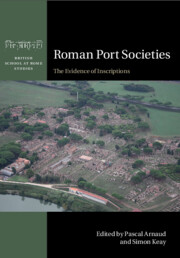Book contents
- Roman Port Societies
- British School at Rome Studies
- Roman Port Societies
- Copyright page
- Contents
- Figures
- Tables
- Contributors
- Abbreviations
- 1 The Context of Roman Mediterranean Port Societies
- 2 Inscriptions and Port Societies
- 3 Stationes and Associations of Merchants at Puteoli and Delos
- 4 Boatmen and their Corpora in the Great Ports of the Roman West (Second to Third Centuries AD)
- 5 Roman Port Societies and Their Collegia
- 6 Port Occupations and Social Hierarchies
- 7 Warehouse Societies
- 8 The Imperial Cult and the Sacred Bonds of Roman Overseas Commerce
- 9 Law and Life in Roman Harbours
- 10 Living Like a Cosmopolitan?
- 11 Ports, Trade and Supply Routes in Western Europe
- 12 The Port Society of Narona
- 13 Municipal Authority, Central Authority and Euergetists at Work at the Port
- 14 The Structure of Mercantile Communities in the Roman World
- 15 Polysemy, Epigraphic Habit and Social Legibility of Maritime Shippers
- 16 Reading Roman Port Societies
- Indexes
- References
10 - Living Like a Cosmopolitan?
On Roman Port City Societies in the WesternMediterranean
Published online by Cambridge University Press: 30 October 2020
- Roman Port Societies
- British School at Rome Studies
- Roman Port Societies
- Copyright page
- Contents
- Figures
- Tables
- Contributors
- Abbreviations
- 1 The Context of Roman Mediterranean Port Societies
- 2 Inscriptions and Port Societies
- 3 Stationes and Associations of Merchants at Puteoli and Delos
- 4 Boatmen and their Corpora in the Great Ports of the Roman West (Second to Third Centuries AD)
- 5 Roman Port Societies and Their Collegia
- 6 Port Occupations and Social Hierarchies
- 7 Warehouse Societies
- 8 The Imperial Cult and the Sacred Bonds of Roman Overseas Commerce
- 9 Law and Life in Roman Harbours
- 10 Living Like a Cosmopolitan?
- 11 Ports, Trade and Supply Routes in Western Europe
- 12 The Port Society of Narona
- 13 Municipal Authority, Central Authority and Euergetists at Work at the Port
- 14 The Structure of Mercantile Communities in the Roman World
- 15 Polysemy, Epigraphic Habit and Social Legibility of Maritime Shippers
- 16 Reading Roman Port Societies
- Indexes
- References
Summary
Port cities are places suigeneris. They are starting points foropening up the world both militarily andeconomically, sites of intersection between land andsea trade, for the local, regional andtrans-regional exchange of goods, and are thusplaces characterized by economic activities,migration and cosmopolitanism. In short, they are‘urban agglomerations of human mobility’. Roman portcities were provided not only with the usualelements of infrastructure and architecture,designed to impress with their monumentally stagedregularity, but also with extravagantly planned‘waterfronts’ (see Figure 12 in Chapter 2): theorthogonal network of streets; aqueducts, fountainbuildings and thermal baths; the centrally locatedsanctuaries dominating squares, columned streetsleading towards them; the towering theatre buildingswhich, tall and massive, caught the eye from theoutside across the houses of the cities; the solidfortifications, completed by harbour basins,breakwaters and gigantic piers; a lighthouse,sometimes made of white marble; and broad coastalroads with inlets to house the crews of incomingships. Greater than life-sized statues flanked theentrances to the harbours, providing safety from theincalculable sea but also from piracy. At the sametime, however, a port city had the function of agate, of both a ‘sally port’ and a ‘gateway’,predominantly the latter – for merchants, members ofthe armed forces and the Imperial administration,magistrates and subaltern public officials; fortravellers, visitors, pilgrims, artists andscholars; for migrants who were not there for shortstays but intended to stay longer, perhaps for good.They completed the society of a municipium or a provincial capital, ofwhich we commonly know only of the élite – that isto say, those who dominated the political discourseand also, due to the donations and honours theyreceived, the public spaces, as they occupied theprestigious offices or key positions of thesocio-economic network of relationships, to form‘sub-élites’, such as those of the members of culticand professional associations: ingenui, peregrini and liberti. Thus, port cities had socialstructures that were both much more differentiatedand more ethnically mixed than those of othercities.
- Type
- Chapter
- Information
- Roman Port SocietiesThe Evidence of Inscriptions, pp. 216 - 240Publisher: Cambridge University PressPrint publication year: 2020

